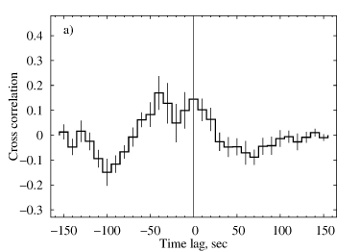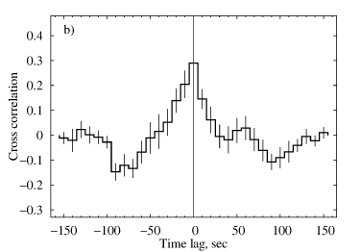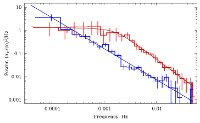|
SS433 is a close binary system, one star is a supergiant, a second one is a
black hole. The supergiant's matter overflows to the neighbouring black
hole and floods the hole with a powerful mass flux: 6 millions of billions
tons per second (that is one Earth mass for 11 days). Even a black hole
cannot accept such an enormous mass flux, a supercritical accretion disk
appears, all the excess gas glows up to several tens of thousands degrees
and is ejected off the disk with enormous velocities. On the disk axes a
huge crater (funnel) is formed composed of the outflowing gas. Astrophycists
of the World know that supercritical disks do exist, however, there are
no direct arguments to proof that phenomenon: the black hole is perfectly
covered by the gas. A gas fountain from a black hole is the
only indication of the supercritical accretion.
SAO researchers have found an evidence of the supercritical accretion onto
a black hole in SS433, which follows from a brightness variability of
the SS433 disk.
The variability has been studied from simultaneous observations taken
in X-ray range from the X-ray Observatory RXTE (Rossi X-ray Time Explorer),
and in optical range obtained on the 6-meter telescope BTA. The scheme
shows an amplitude of emission variability as depending on frequency f.
A flat region in the scheme is a "visiting card" of the supercritical disk,
that is the place where the disk is sharply expanded, an amplitude at the
all frequencies is equiprobable. In the second figure the real observations
are shown in red, where the flat region has been discovered. This proofs
a presence of the supercritical accretion disk in SS433.
In the third figure a correlation between soft X-rays and optical is shown
in left, and the same but between hard X-rays and optical is shown in right.
In the soft X-ray range the X-ray jets of SS433 are radiated, but hard
X-rays and optical are formed due to reflection at the funnel walls.
Originally the radiation come from the bottom of the funnel. Between
hard X-rays and optical there are no delays, they are reflected and come
to the observer simultaneously. The soft X-rays (left) is delayed regarding
to the optical. Because both the hard X-rays and optical propagate with
speed of light, they simultaneously reflected off the walls. The jets
(soft X-rays) propagate with a velocity of a quarter of speed of light,
they appear from the edge of the crater on 50 seconds later. The presence of
the crater (the funnel) testifies that the disk in SS433 is supercritical.
K.Atapin, S.Fabrika, F.Medvedev, A.Vinokurov, Mon. Not. R. astr. Soc. 446,
893, 2015
Contact - S.Fabrika

|

|
|
Fig.3.
Correlation functions of the soft X-rays and optical radiation (a) and
the hard X-rays and optical (b). The soft X-rays (a) are formed in jets,
they propagate with a velocity of a quarter of the velocity of light,
that results in a delay. The jets appear from the edge of the crater
(funnel) on 50 seconds later than the reflected optical radiation.
The hard X-rays and optical (b) propagate with speed of light, they
simultaneously reflected at the funnel walls. We may see only
reflected light, the main source is located deeply at the funnel bottom.
|
|

Fig.1.
An expected power spectrum (scheme) of the supercritical accretion disk.
The flat region between frequencies f_1 and f_2 is an evidence that in
this place the disk becomes thick (spherization radius of the disk).
At the spherization radius all signals of the accretion disk are
independend ("white noise"). From left side of f_1, at lower frequencies,
the disk is still thin (standard disk). From left side of f_2, at higher
frequancies, the variability is smoothed by the funnel.

Fig.2.
The observed power spectra of X-ray emission at different orientations of
the accretion disk and the funnel: the maximal opening of the disk to
the observer (red) and the edge-on disk (blue). When the disk is open to
the observer (red) we can see the funnel, here we have detected the flat
region. When the disk and the funnel are totally blocked (blue) we see
only the reflected radiation off the clouds far away from the disk.
The frequency in Hertz (0.001 Hz corresponds to 1000-second period).
|



